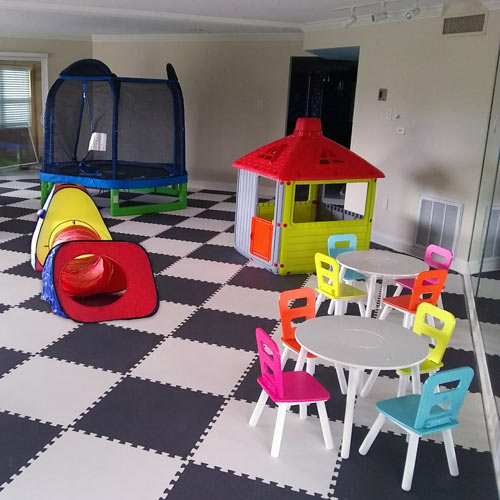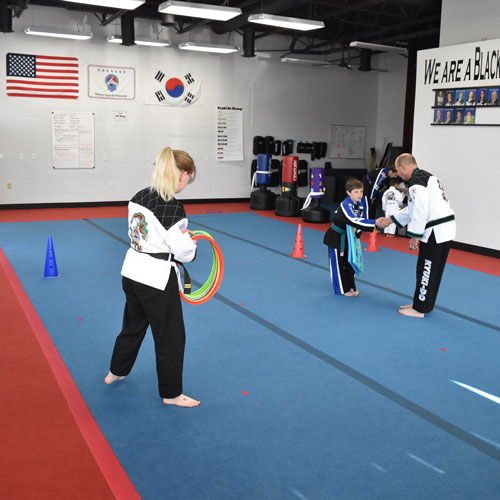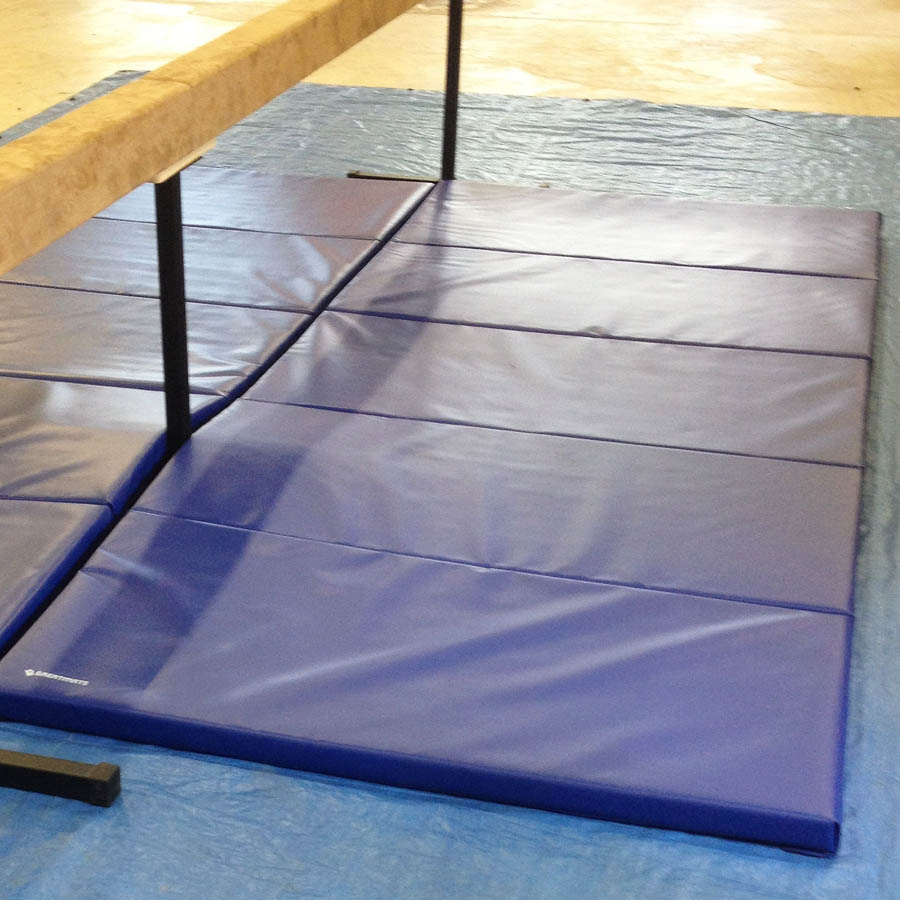How to Install Foam Floor Tiles, Mats and Rolls
By Created: February, 2018 - Modified: August, 2023
Related Product: Foam Kids and Gym Mats Premium 5/8 Inch x 2x2 Ft.
While foam flooring has built a reputation as a go-to flooring for kids rooms and athletic facilities, the uses extend far beyond the gym or playroom. They have become a staple portable anti fatigue and show flooring solution for professional trade show booths as well as virtually every room in the house.
As the foam flooring industry has evolved, you can even find foam floors that look like wood or cork, some even have carpet or vinyl tops. No longer are you restricted to foam floors that look like they have evolved from a box of crayons (although there is a place for that as well).
Let's take a look at the most common installation methods for each type of foam floor.
Foam Tile Installation

When it comes to installing foam floor tiles, just think about it as one of the simplest jumbo sized jigsaw puzzles you've ever come across. If you are building a foam floor out of all center tiles, each tile will have the same size (generally 2x2 feet or 1x1 meter) and shape (most often square). It's just a matter of whether or not they feature a universal interlocking system and whether or not they are reversible.
Foam tiles with universal interlocks can be connected together in any direction without disrupting the flow of your floor. If they do not have a universal interlocking system, the tiles will be directional - meaning you should watch for arrows on the back side or unique corners that will guide you in making sure the tiles all face the same direction.
Closed cell foams such as EVA foam is the most common material for foam tiles. Many EVA foam tiles are reversible and some even give you a different color or texture option on the flip side.
Others foam tiles will have one finished surface and one clear underside. This option will most likely be the case if your foam tiles have a vinyl or carpet topped surface. It will also most likely apply if the foam is a cross-linked polyethylene variety - rather than EVA. If your foam flooring is a extra cushiony mat wrapped in vinyl, it will likely have an open cell foam core, such as polyurethane foam.
One major benefit to closed cell EVA and Cross-Linked Polyethylene foam floors is that they will not absorb moisture. The carpet on carpet-bonded foam tiles or mats, may not always be waterproof, however.
Another benefit is that these tiles are typically very easy to custom cut if necessary using little more than a sharp utility knife. The tiles are also conveniently sized for easy transportation and installation.
One drawback to this type of flooring, however is the fact that the puzzle edges may be visible at the seams and leaves a non-traditional edge to your flooring if you do not cut them to fit for wall-to-wall installation.
Luckily many varieties of interlocking foam tiles also come with border strips to give you a finished straight edge on your floor. Others offer edge and corner pieces with built in finished edges. If the mat is thick enough, you may even find options with beveled edges on the straight sides or ramped border strips.
Rolled Foam Floor Installation

If you're looking to cover a big area in a hurry - and without many seams, foam rolls are the way to go. These form if flooring typically uses a cross-linked polyethylene foam base, covered with a carpet or vinyl surface material. The foam base is typically scored for easier rolling. Keep in mind, these mats should not flipped over as the bottom side of the mat is not designed for direct contact with foot traffic, equipment or furniture.
You can also find foam rolls that are designed specifically to add a cushioned underlayment layer under other floors. This is most common for athletic environments. This rolls will not be scored, as they are typically thinner and easier to roll, but you still should not use them without an added surface flooring layer.
The scored version with an already bonded surface layer will be easier to install than underlayment foam rolls as they lay much flatter even after being stored in a rolled up position for long periods of time. Underlayment rolls will have some memory from being rolled up - another good reason for installing another surface over top, as its weight helps flatten you foam floor.
Either way, rolled foam flooring will cover large spaces much faster than tiles and leave far fewer seams. Their protective surface coverings also make them much more resistant to punctures from things such as high heels, chairs or martial arts weapons.
In most cases, these floors will not need adhesives for installation, but double sided tape has been known to be used in some cases. Connecting the rolls will require the use of tape or hook and loop connector strips, depending on the surface material.
Keep in mind, this type of flooring will not have ramped edges, but they will have straight edges.
With all closed cell foam flooring installations, keep in mind that the foam material will expand and contract with temperature and humidity variations, so make sure you remember to leave approximately 1/2 inch of room around the perimeter of the foam floor so that it can expand without cause buckles in your floor.
Foam Mat Installation

The major difference with foam floor mats is that they are able to be used alone, without the need for multiple mats to be joined together. Many can, however, be joined together to make a larger matted flooring surface.
In many cases foam rolls can dual as foam mats, but foam floor mats also come in a couple other forms. There are folding mats and traditional 1x2 meter martial arts mats. The core material for these can vary from polyethylene foam to polyurethane foam to a combination of the two.
Folding mats not generally designed for permanent installations - thus the folding feature. These mats are designed for portability and the ability to store in a much more compact form. With that being said, they generally come with hook and loop connector strips on either two or four sides. This allows to ''stick'' multiple mats together to make either a tumbling runway or expand your flooring in multiple directions to a much wider padded surface.
Keep in mind that folding mats are not considered waterproof even though the vinyl cover will not absorb moisture. This is because the vinyl has been punctured for stitching and the core foam often includes open cell foams that can absorb moisture.
Your traditional 1x2 meter martial arts floor mats are going to be by far your heaviest foam flooring option. Greatmats 1x2 meter mats are ruggedly built with a non-slip rubberized bottom and heavy duty vinyl top. Although they are rarely used by themselves, they do not connect together. They are simply butted up next to each other and are held in place by either their weight on the non-skid bottom or a being framed in - or both.
These floor mats utilize an open cell foam core, so exposure to moisture and liquids should be kept to a minimum.
Folding mats should not be cut to fit while 1x2 mats can be custom cut, but there is a much more labor intensive process to do so, due to the fact that all edges will need to remain covered/wrapped by vinyl when finished.
Now that you know a little more about the different styles of installation available for foam flooring you should have a much better idea of which style will work best for your situation.
Enjoy your new foam floor!














